



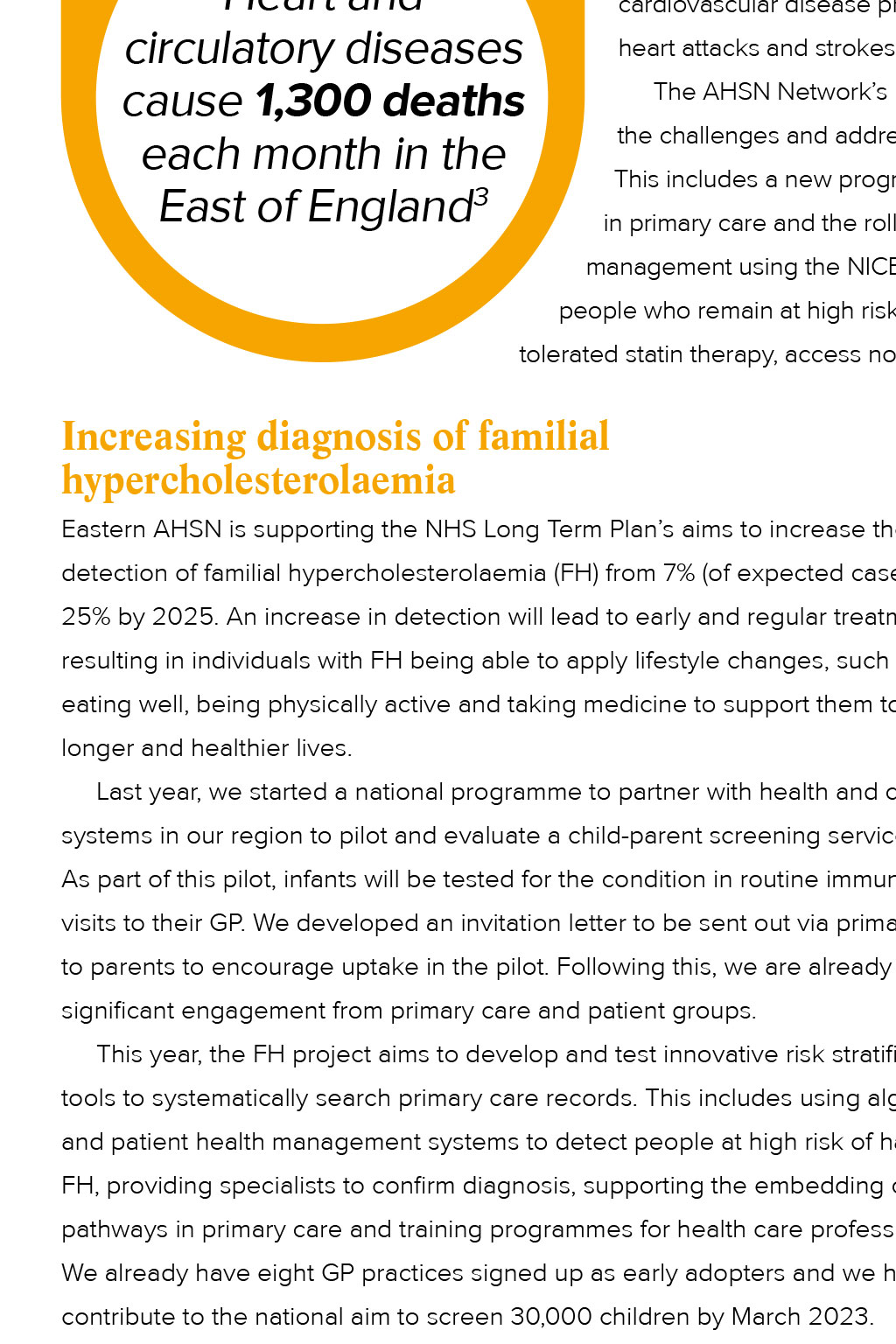
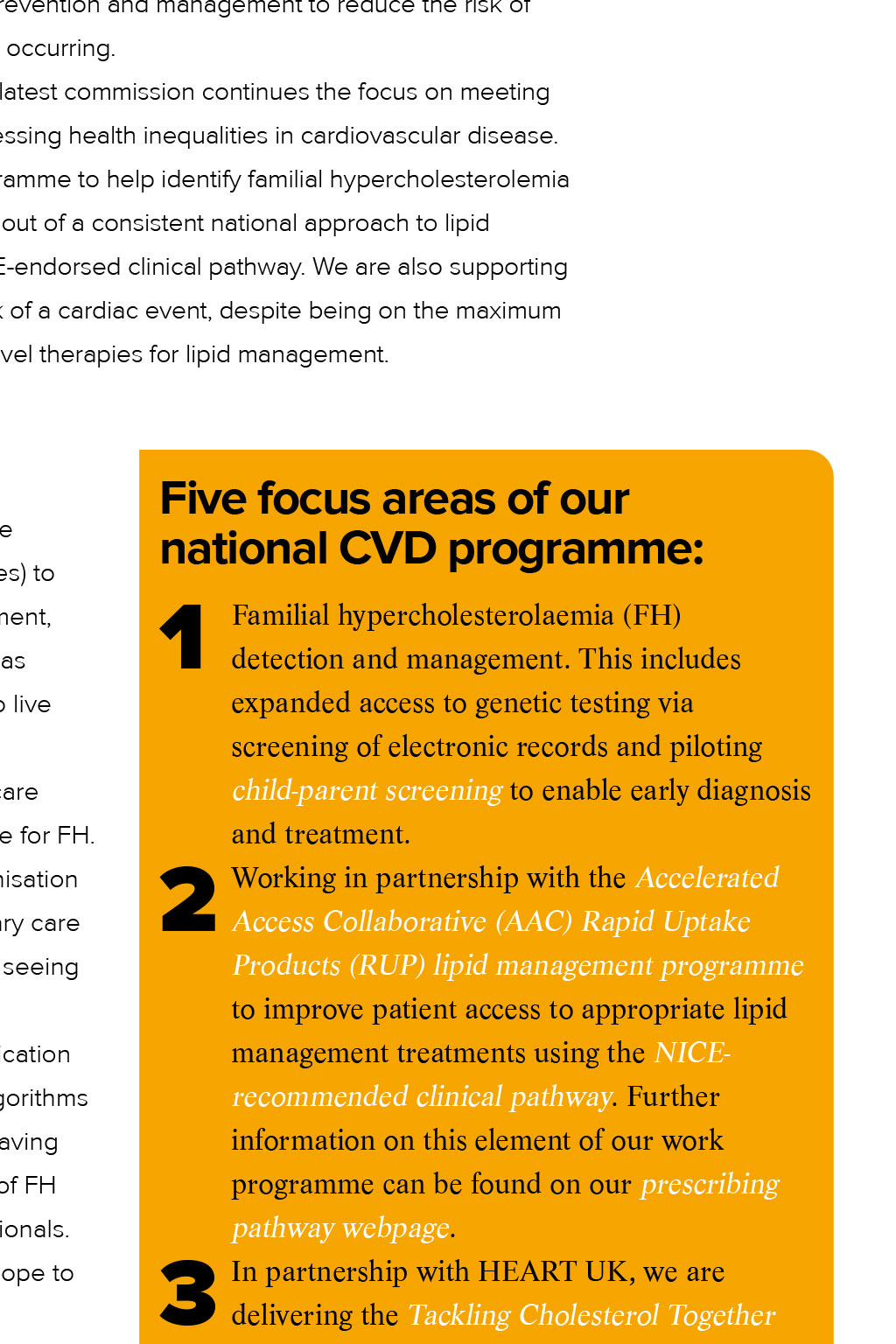
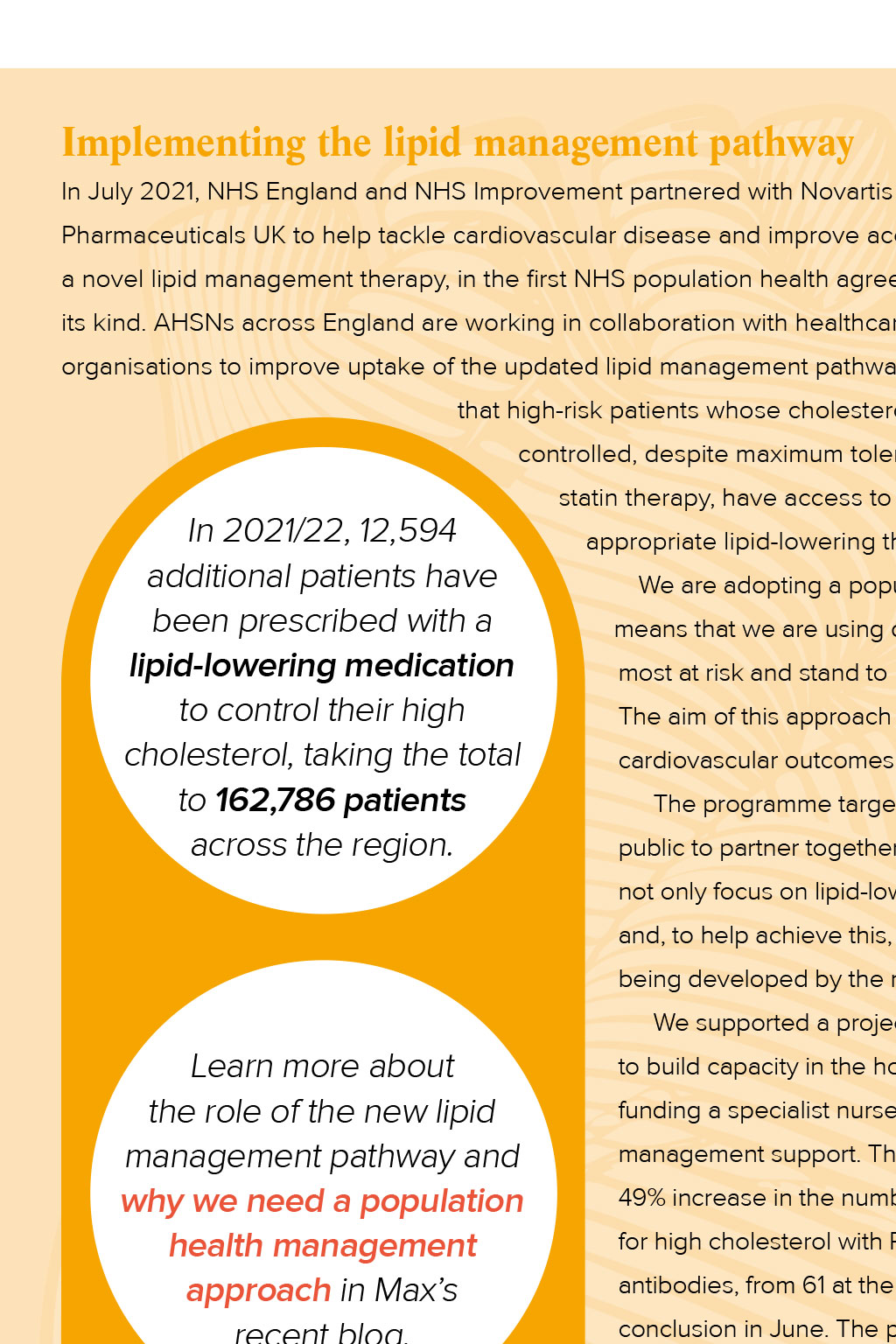

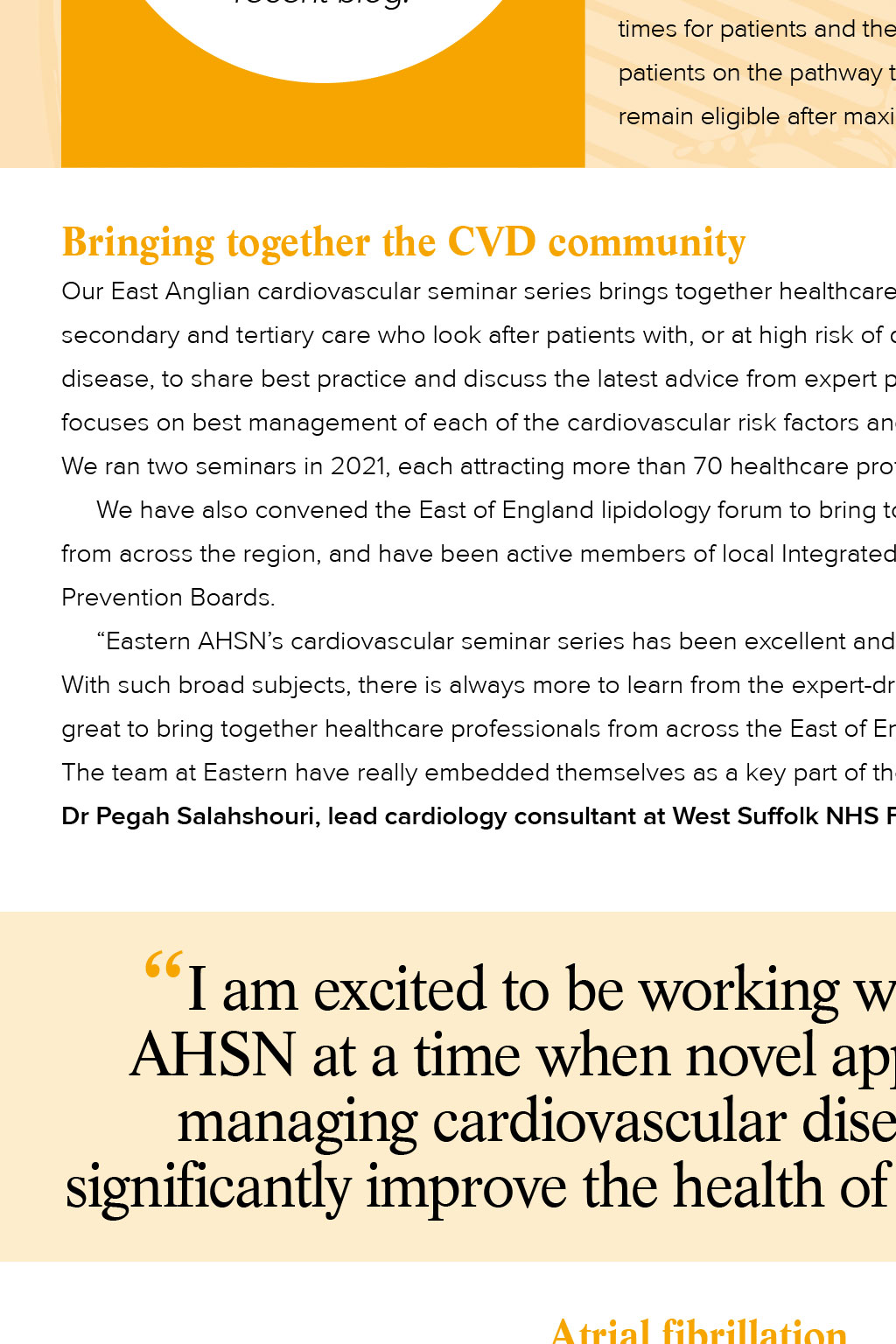

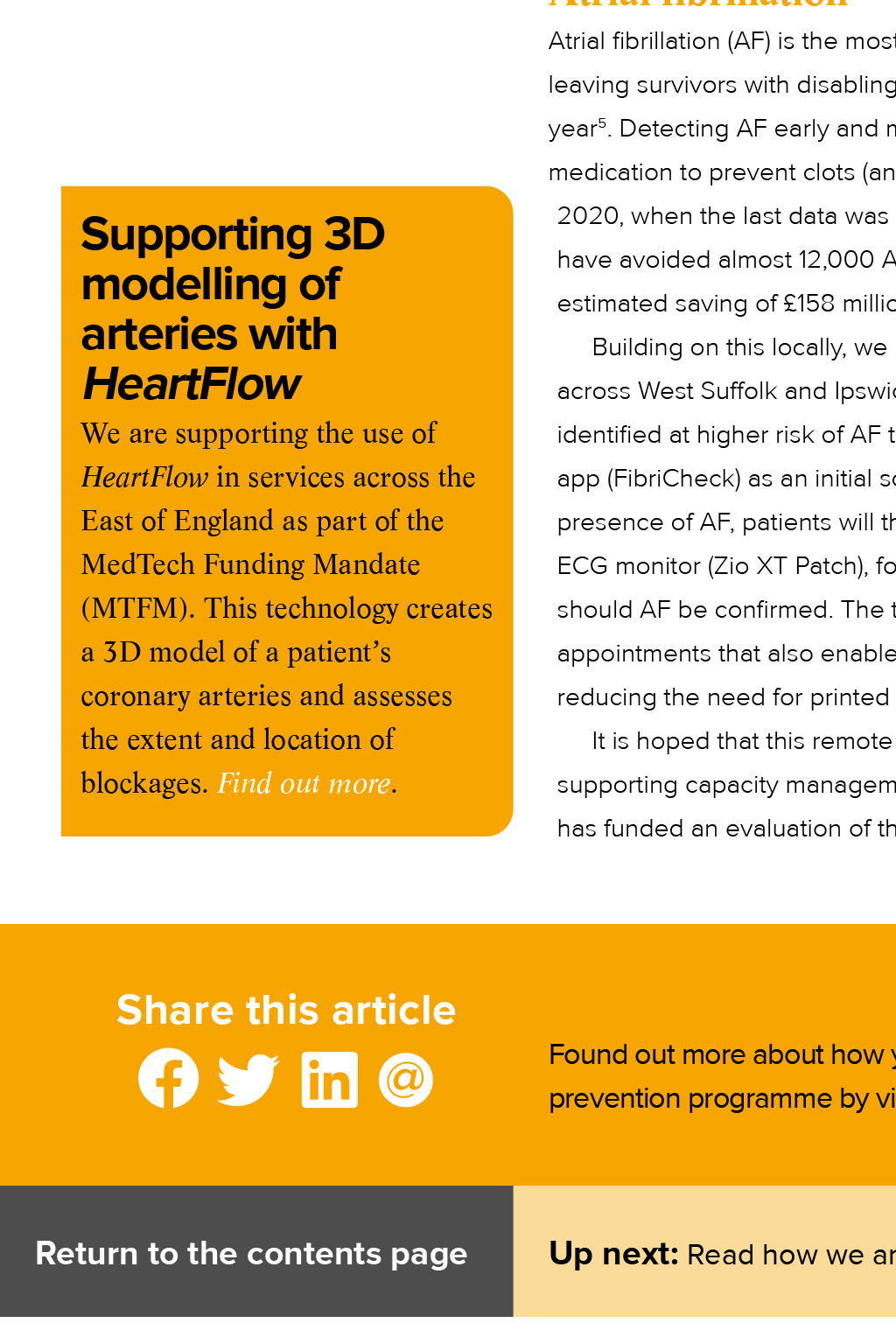
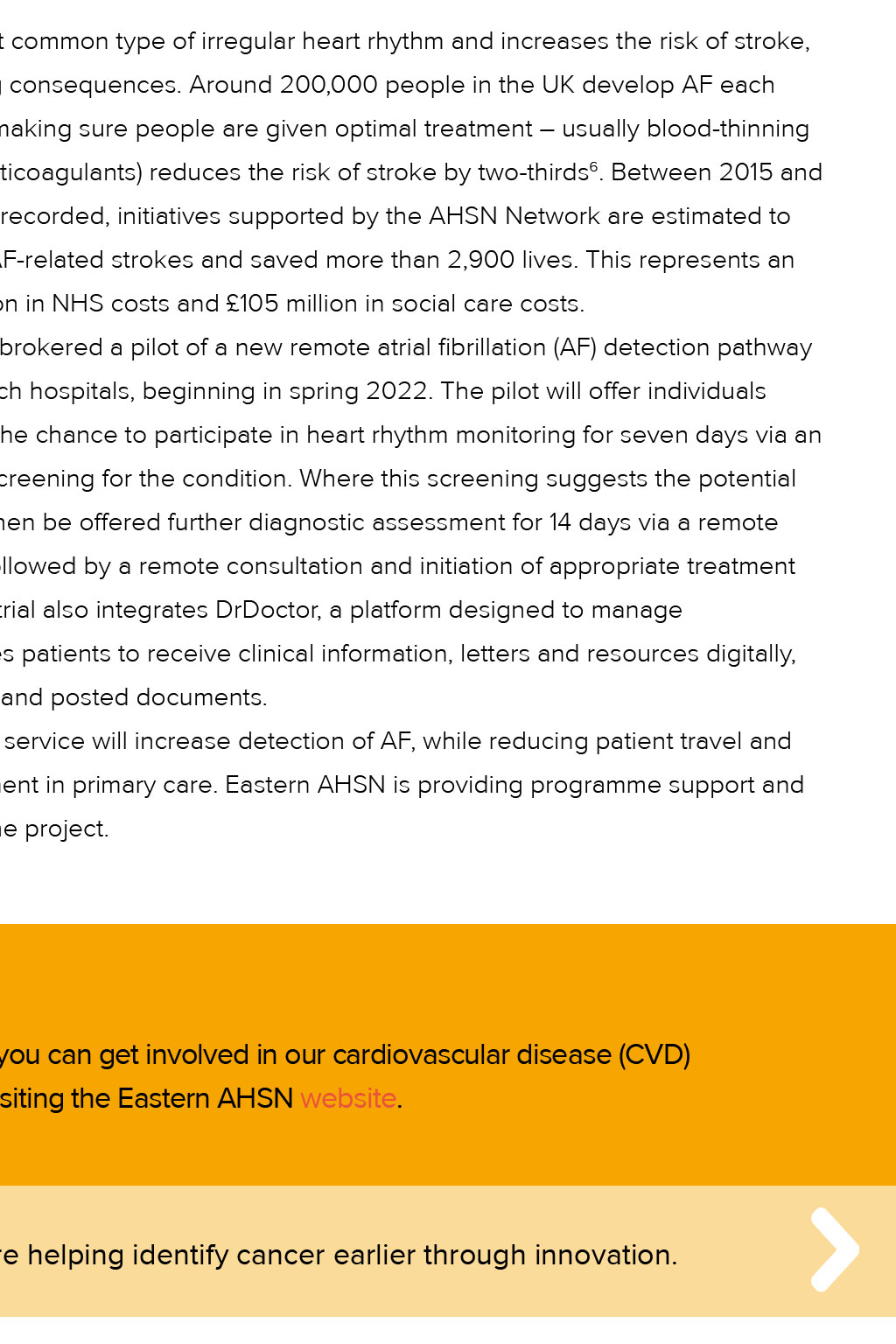
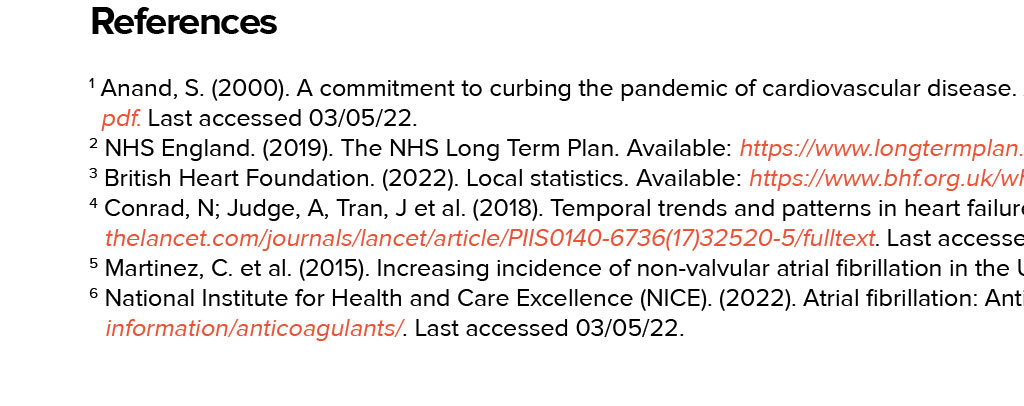
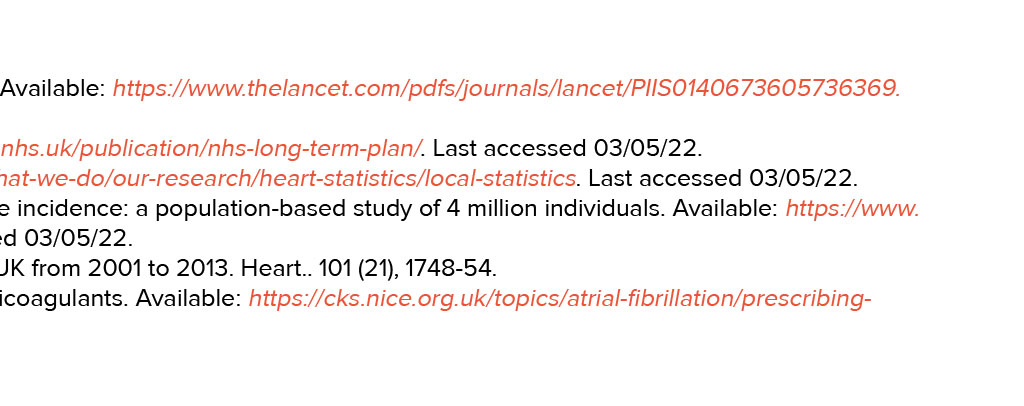















Focus on: cardiovascular disease Taking a populationapproach to led improving heart health The scale of the issue: Dr Max Hickman, clinical advisor for Eastern AHSNs cardiovascular disease programme, explains how our work is focusing on both prevention and management of heart conditions across the region A Cardiovascular disease affects around seven million people in 2 the UK s the NHS recovers and resets from COVID-19, it is worth remembering that we are also globally experiencing a pandemic in cardiovascular disease1 (CVD). Even before it was discovered that patients with these underlying conditions are at much higher risk of dying from COVID-19, CVD was responsible for one in four deaths in the UK and is the largest cause of premature mortality in deprived areas. Socioeconomically deprived groups have also been shown to have consistently worse outcomes than the most affluent groups. They face a 20% higher risk of all-cause hospitalisation even after adjustment for other factors. This inequality is not changing and has now 4 persisted for more than 20 years . Around 670,000 people are living with heart disease in the East of 3 England Heart and circulatory diseases cause 1,300 deaths each month in the 3 East of England The AHSN Network has led successful major national programmes in cardiovascular disease prevention and management to reduce the risk of heart attacks and strokes occurring. The AHSN Networks latest commission continues the focus on meeting the challenges and addressing health inequalities in cardiovascular disease. This includes a new programme to help identify familial hypercholesterolemia in primary care and the rollout of a consistent national approach to lipid management using the NICE-endorsed clinical pathway. We are also supporting people who remain at high risk of a cardiac event, despite being on the maximum tolerated statin therapy, access novel therapies for lipid management. Increasing diagnosis of familial hypercholesterolaemia Eastern AHSN is supporting the NHS Long Term Plans aims to increase the detection of familial hypercholesterolaemia (FH) from 7% (of expected cases) to 25% by 2025. An increase in detection will lead to early and regular treatment, resulting in individuals with FH being able to apply lifestyle changes, such as eating well, being physically active and taking medicine to support them to live Five focus areas of our national CVD programme: 1 longer and healthier lives. Last year, we started a national programme to partner with health and care systems in our region to pilot and evaluate a child-parent screening service for FH. As part of this pilot, infants will be tested for the condition in routine immunisation visits to their GP. We developed an invitation letter to be sent out via primary care to parents to encourage uptake in the pilot. Following this, we are already seeing 2 significant engagement from primary care and patient groups. This year, the FH project aims to develop and test innovative risk stratification tools to systematically search primary care records. This includes using algorithms and patient health management systems to detect people at high risk of having FH, providing specialists to confirm diagnosis, supporting the embedding of FH pathways in primary care and training programmes for health care professionals. We already have eight GP practices signed up as early adopters and we hope to contribute to the national aim to screen 30,000 children by March 2023. Implementing the lipid management pathway In July 2021, NHS England and NHS Improvement partnered with Novartis 3 4 Pharmaceuticals UK to help tackle cardiovascular disease and improve access to a novel lipid management therapy, in the first NHS population health agreement of its kind. AHSNs across England are working in collaboration with healthcare organisations to improve uptake of the updated lipid management pathway, so that high-risk patients whose cholesterol is not 5 Familial hypercholesterolaemia (FH) detection and management. This includes expanded access to genetic testing via screening of electronic records and piloting child-parent screening to enable early diagnosis and treatment. Working in partnership with the Accelerated Access Collaborative (AAC) Rapid Uptake Products (RUP) lipid management programme to improve patient access to appropriate lipid management treatments using the NICErecommended clinical pathway. Further information on this element of our work programme can be found on our prescribing pathway webpage. In partnership with HEART UK, we are delivering the Tackling Cholesterol Together education programme and the Cholesterol Now campaign. Supporting proactive care for hypertension, which involves working with healthcare professionals to identify and treat patients with high blood pressure, including through self-management and remote monitoring. Building on our previous work to increase the detection of atrial fibrillation (AF) in our region. controlled, despite maximum tolerated In 2021/22, 12,594 additional patients have been prescribed with a lipid-lowering medication to control their high cholesterol, taking the total to 162,786 patients across the region. statin therapy, have access to appropriate lipid-lowering therapies. We are adopting a population health management approach, which means that we are using data to prioritise those in our community who are most at risk and stand to benefit most from access to lipid-lowering therapies. The aim of this approach is to reverse the ever-increasing gap in cardiovascular outcomes between prosperous and low-income communities. The programme targets not only health professionals, but also the wider public to partner together and improve cardiovascular health. The objectives not only focus on lipid-lowering therapies, but also on healthier lifestyles and, to help achieve this, we are partnering with the neighbourhood teams being developed by the new integrated care boards. We supported a project at Addenbrookes Hospital Learn more about the role of the new lipid management pathway and why we need a population health management approach in Maxs recent blog. to build capacity in the hospitals lipid clinic through funding a specialist nurse and giving project management support. The project saw a more than 49% increase in the number of patients being treated for high cholesterol with PCSK9 inhibiting monoclonal antibodies, from 61 at the start of the project to 91 at its conclusion in June. The project has reduced waiting times for patients and there has been an increase in patients on the pathway to start treatment should they remain eligible after maximising their statin regime. Dr Max Hickman explains the role of the new lipid management pathway and why we need to take a population health management approach to tackling cardiovascular disease. Bringing together the CVD community Our East Anglian cardiovascular seminar series brings together healthcare professionals across primary, secondary and tertiary care who look after patients with, or at high risk of developing, cardiovascular disease, to share best practice and discuss the latest advice from expert partners. Each online seminar focuses on best management of each of the cardiovascular risk factors and of the patient groups at risk. We ran two seminars in 2021, each attracting more than 70 healthcare professionals. Find out more. We have also convened the East of England lipidology forum to bring together lipid specialists from across the region, and have been active members of local Integrated Care System CVD Prevention Boards. Eastern AHSNs cardiovascular seminar series has been excellent and hugely informative. With such broad subjects, there is always more to learn from the expert-driven sessions. It is also great to bring together healthcare professionals from across the East of England to share best practice. The team at Eastern have really embedded themselves as a key part of the CVD community Dr Pegah Salahshouri, lead cardiology consultant at West Suffolk NHS Foundation Trust I am excited to be working with Eastern AHSN at a time when novel approaches to managing cardiovascular disease could significantly improve the health of our patients Supporting management of CVD with Liberate Pro We have partnered with the Suffolk and North East Essex Integrated Care System to pilot the use of Liberate Pro in cardiovascular services. This tool allows a clinician to record a patient consultation and send it to them afterwards with further guidance, to support better understanding of their condition and how to manage it. We brokered the pilot and are supporting the evaluation, which is expected in summer 2022. Find out more about Liberate Pro. Atrial fibrillation Atrial fibrillation (AF) is the most common type of irregular heart rhythm and increases the risk of stroke, leaving survivors with disabling consequences. Around 200,000 people in the UK develop AF each year5. Detecting AF early and making sure people are given optimal treatment usually blood-thinning Supporting 3D modelling of arteries with HeartFlow medication to prevent clots (anticoagulants) reduces the risk of stroke by two-thirds6. Between 2015 and We are supporting the use of HeartFlow in services across the East of England as part of the MedTech Funding Mandate (MTFM). This technology creates a 3D model of a patients coronary arteries and assesses the extent and location of blockages. Find out more. across West Suffolk and Ipswich hospitals, beginning in spring 2022. The pilot will offer individuals 2020, when the last data was recorded, initiatives supported by the AHSN Network are estimated to have avoided almost 12,000 AF-related strokes and saved more than 2,900 lives. This represents an estimated saving of 158 million in NHS costs and 105 million in social care costs. Building on this locally, we brokered a pilot of a new remote atrial fibrillation (AF) detection pathway identified at higher risk of AF the chance to participate in heart rhythm monitoring for seven days via an app (FibriCheck) as an initial screening for the condition. Where this screening suggests the potential presence of AF, patients will then be offered further diagnostic assessment for 14 days via a remote ECG monitor (Zio XT Patch), followed by a remote consultation and initiation of appropriate treatment should AF be confirmed. The trial also integrates DrDoctor, a platform designed to manage appointments that also enables patients to receive clinical information, letters and resources digitally, reducing the need for printed and posted documents. It is hoped that this remote service will increase detection of AF, while reducing patient travel and supporting capacity management in primary care. Eastern AHSN is providing programme support and has funded an evaluation of the project. Share this article Return to the contents page Found out more about how you can get involved in our cardiovascular disease (CVD) prevention programme by visiting the Eastern AHSN website. Up next: Read how we are helping identify cancer earlier through innovation. References Anand, S. (2000). A commitment to curbing the pandemic of cardiovascular disease. Available: https://www.thelancet.com/pdfs/journals/lancet/PIIS0140673605736369. pdf. Last accessed 03/05/22. 2 NHS England. (2019). The NHS Long Term Plan. Available: https://www.longtermplan.nhs.uk/publication/nhs-long-term-plan/. Last accessed 03/05/22. 3 British Heart Foundation. (2022). Local statistics. Available: https://www.bhf.org.uk/what-we-do/our-research/heart-statistics/local-statistics. Last accessed 03/05/22. 4 Conrad, N; Judge, A, Tran, J et al. (2018). Temporal trends and patterns in heart failure incidence: a population-based study of 4 million individuals. Available: https://www. thelancet.com/journals/lancet/article/PIIS0140-6736(17)32520-5/fulltext. Last accessed 03/05/22. 5 Martinez, C. et al. (2015). Increasing incidence of non-valvular atrial fibrillation in the UK from 2001 to 2013. Heart.. 101 (21), 1748-54. 6 National Institute for Health and Care Excellence (NICE). (2022). Atrial fibrillation: Anticoagulants. Available: https://cks.nice.org.uk/topics/atrial-fibrillation/prescribinginformation/anticoagulants/. Last accessed 03/05/22. 1